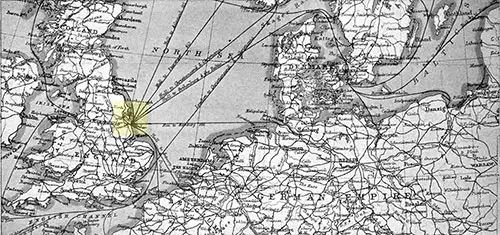Port of Hull, England
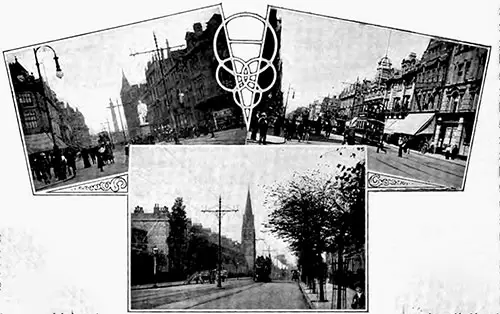
Collage of the City of Hull. King Edward Street Looking East and West, Anlaby Street, Looking West. GGA Image ID # 1464fd9eab
Hull's right to be numbered among the great seaports of the world does not rest simply upon its present preeminence as a shipping port. It has older claims to the distinction.
Britain's Great and Busy Seaport on the North Sea.
[By a Special Correspondent of Don's Review at Hull.]
Hull's right to be numbered among the great seaports of the world does not rest simply upon its present preeminence as a shipping port. It has older claims to the distinction. It has always ranked as one of the leading ports of England and as the gateway through which a large portion of the commerce of Yorkshire and the English midlands has passed.
The history of the city dates far back into the shadowy past. It owes its origin probably to the Danes who landed on the eastern coast of England in the eighth and ninth centuries.
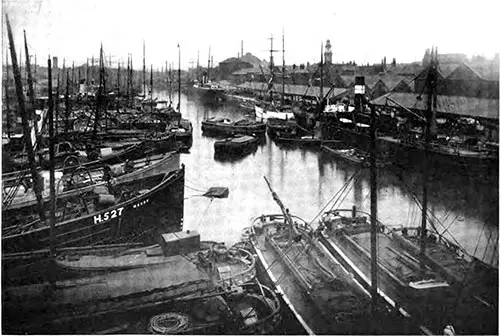
Hull's Busy Waterfront - Queen's Dock. GGA Image ID # 14651ad9a4
To these invaders the River Humber offered an easy route for entering the country, as is proved by the large numbers of Scandinavian village names still existing in the vicinity.
One of the settlements of these invaders, on the right bank of the River Hull where it empties into the Humber estuary, which at this point is between two and three miles wide, formed the nucleus of the modern city of Hull.
Ships were engaged in a rude sort of commerce between this settlement and continental ports when William the Conqueror landed at Hastings. In 1292 King Edward I acquired the place as a royal possession, and thenceforth it became the King's Town upon Hull, or Kingston-Upon-Hull, which is still its distinction in all legal documents.
If America had never been discovered Hull would have become the Liverpool of eastern England, and it would have ranked after London, if not before that city, as the chief entrepot of the United Kingdom.
Its geographical situation makes this evident. It lies directly across the German Ocean from the chief ports of northern Europe, and it is the natural entrance for the commerce between those ports and England.
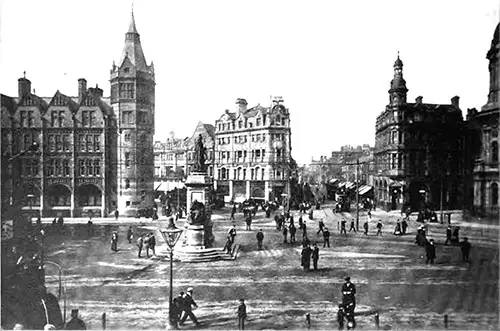
Victoria Square, Hull. GGA Image ID # 1465629563
Few tourists from America in laying out their route take Hull into their plans. And yet it is situated on the direct route to the continent from Liverpool, and it is a convenient port from which to start from England on a tour of the continent of Europe. The sectional map will illustrate this fact. From Liverpool to Hull is a journey of four hours.
Hull's Strategic Position Commanding the Commerce of the North Sea. GGA Image ID # 1466b0e1b4
From Hull regular lines of steamers run to all the leading ports of the Baltic and North Seas, and enable a tourist to make a round trip through Europe without doubling on his route, as is necessary if the journey to and from the continent is made by way of Dover and Calais.
The docks, with their network of railway communication, form an important factor in the trade and prosperity of the seaport. Their equipment is of the most modern character, embodying all the np-to-date appliances for handling the merchandise which enters or is sent out from this center of shipping activity.
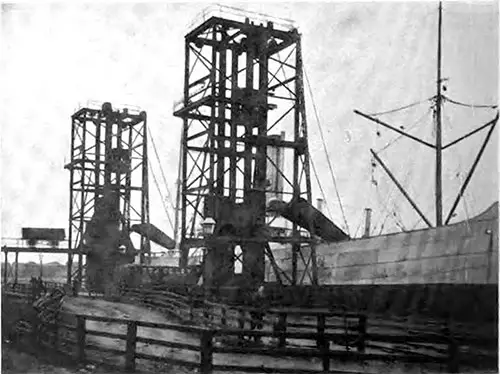
Double Coal Hoists - Alexandra Docks at Hull. GGA Image ID # 1465fecb53
Steam, hydraulic and electric cranes of large capacity; special machinery for dealing with grain in bulk; special coaling cranes, hydraulic hoists and tips, by which the shipment of coal can be rapidly and conveniently carried on; special arrangements for dealing with timber, cattle, sheep and pigs, manufactured goods and raw material, fruit, fish, vegetables, etc., are provided and maintained in the highest state of efficiency.
In the department for the storage of grain there are twenty-four warehouses of large capacity owned by the North Eastern Railway Company and capable of containing 340,000 quarters, while there is space also for about 20,000 tons of general merchandise.
In addition to this there is large accommodation at the Alexandra Dock, provided by the Hull and Barnsley Company, and there are also large warehouses at the Old Harbor, so that over a million quarters of grain can be stored at the port. Ample provision is also made for the storage of guano and other fertilizing agents.
Parliament has recently sanctioned proposals for a large new dock to be constructed jointly by the two dock owning authorities of the port, viz., the North Eastern Railway and the Hull and Barnsley Railway Companies, which will be nearer the sea than the present dock.
It will have an entrance capable of accommodating the largest vessel likely to be built and be accessible to vessels of smaller dimensions at all states of the tide.
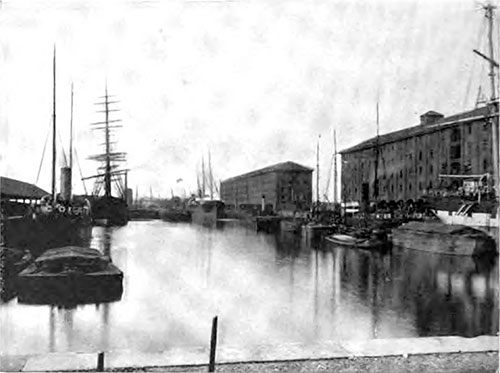
View of Albert Docks, Hull. GGA Image ID # 1466a0f91c
It is intended that this dock shall be over 56 acres in extent and be capable of enlargement to not less than twice that size when required. The contracts have been lot and work has been begun, and it is expected that the dock will be finished in five years at most.
This will add about 40 per cent. to the dock facilities of Hull, and in connection with the other docks will line nearly the whole Humber River front of the city with docks.
The Wilson Line of Hull
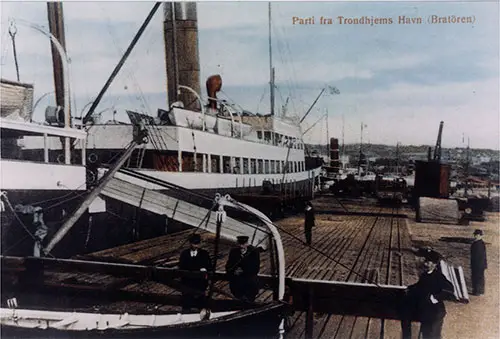
The SS Aaro of the Wilson Line of Hull Docked at Trondheim, Norway circa 1910. GGA Image ID # 1466d80bed
Hull's facilities as a shipping port have given birth to some of the most best-known shipping firms in England. The largest among them is the Messrs. Thomas Wilson Sons & Co., Ltd. It was founded by the late Thomas Wilson about eighty years ago, and from a small beginning has grown, until today it ranks as the largest private shipping firm in the world.
It has lines running to Ghent, Rouen, Liverpool, Newcastle, Marseilles, Genoa, Leghorn, Naples, to the Scandinavian and Baltic ports, and to New York. The line to New York was established in 1875 and has been maintained regularly since, notwithstanding the close competition Hull has had to meet from Liverpool and Southampton.
The Wilson line of steamers is numerically greater than the fleets of not a few prominent naval powers. It numbers ninety-one vessels and three tugs, with an aggregate tonnage of nearly 200,000. The enterprise of the firm has been a leading factor in making Hull the third port in England in exports and imports.
Other shipping firms in Hull are Messrs. Brown, Atkinson & Co., G. R. Sanderson & Co., W. A. Massey & Co., Alexander Meek & Sons, William Moran & Co., Henry Samman & Co., Jacob Hessler & Co., W. Tulley & Co., and W. R. Johnson & Son.
To attempt to enumerate the foreign ports with which Hull is in more or less constant communication would be practically to count up the principal shipping places of the world, for its trade is world-wide.
Naturally, from its position, those of the northern countries of Europe figure largely in the returns. Rotterdam heads the list in annual tonnage, and New York, though in the opposite direction, comes next.
Hamburg, Gothenburg, Cronstadt, Christiania, Bremen, Amsterdam, Antwerp, Riga, Trondheim, Stockholm, Konigsberg, Copenhagen, etc., are some of the northern ports, while Alexandria, San Francisco, Boston, New Orleans, Buenos Ayres, Bombay, Smyrna, Melbourne, etc., are a few of the more distant.
Hull Imports
Hull imports grain (wheat, maize, barley, beans, peas, oats and sundries, buckwheat, etc.); seed (cotton seed, linseed, rapeseed, canary seed, etc. ; timber, stone, iron and other minerals, sand guano, nitrates and the like; foodstuffs in great variety, such as herrings, frozen meat, sugar, provisions, rice, etc.; fruits in the way of oranges, lemons, raisins, dates, apples. etc., and vegetables in large quantities, and in other departments flax, hemp, pork, hams, margarine, cheese, etc. Petroleum is also imported extensively.
Hull Exports
The experts from Hull comprise a wide range of staples and commodities, such as coal, coke, etc.; cotton and linen goods, jute goods; woolen goods in the way of manufacturing fabrics, yarns, etc.; hardware, machinery, agricultural implements and the like.
Shipbuilding is actively carried on in the Humber district, and although the vessels built are mostly small (chiefly trawlers and barges), the aggregate tonnage is considerable, amounting to a total of 30,000 tons annually.
It is claimed for the merchants of Hull that they were the pioneers in whale fishing in England, and the whale, regarded by naturalists as the standard for descriptive purposes, forms a prominent object in the Hull Municipal Museum.
Ships were fitted out at this port for the whale fishery as early as the year 1598, about half a century after the discovery of Greenland by Sir Hugh Willoughby. When whale fishing became unprofitable the seafaring men of Hull turned their attention to food fishing, and they have been so successful as to make the Humber River one of the busiest fishing centers in the world.
Trawling Fleet
The North Sea steam trawling fleet, which belongs to Hull and Grimsby, is made up of two classes of boats, known as "box trawlers" and "single boaters." The latter act more or less independently, while the "box trawlers" fish in fleets of sixty or seventy boats, some forty or more being on the fishing ground all the time, winter and summer.
Their method of operation is as follows: The individual boats leave Hull provisioned and coaled for two weeks. With information obtained from incoming trawlers they pick up the fleet and fish until a return to the Humber is made necessary by want of supplies.
Every morning the fleet assembles and each boat delivers its twenty-four hours' catch, sorted and packed in boxes (hence the name "box trawlers"), to the cutter—another trawler of perhaps a little more power than the ordinary boats.
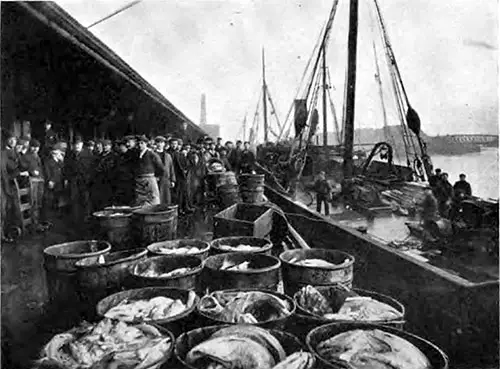
The Billingsgate of Hull. GGA Image ID # 14657c92c5
The cutter, having packed the boxes in ice, leaves at once for London and delivers them at Billingsgate Market. She then drops down the river, takes on coal and ice, and steams back to the fleet to receive another cargo of fish for London.
During the night one of the captains, who acts as the admiral of the fleet, by means of rockets and flares indicates to the vessels fishing his position and the general course to take to avoid the danger of fouling the trawls.
Each trawler while trawling carries certain characteristic lights, established by international agreement, which indicates her nature and occupation and her inability to move out of the way with the trawl down.
It is probable that the sight of these rockets led the Russians to imagine this fleet of innocent fishermen to be a squadron of terrible Japanese boats and led to the attack which nearly involved Russia in a war with England.
The Fishing Dock
The St. Andrew's Dock in Hull, or "Fishing Dock" as it is generally called, is at the west end of the city and is given up entirely to the steam trawlers. Here can be seen trawlers tied up two or three deep along the stone sides of the dock, with their trawls tied up in the rigging to dry and the great "otter boards" hanging from the davits at their bows.
A great variety of fish is caught and brought here, such as cod, coalfish, plaice, witches, turbot, and, rarely, soles. On the cement floor may be seen great halibut and "barndoor" skates, dressed ready for the market.
Here the fish are auctioned off to the highest bidder, who takes his purchase to a train of freight cars in waiting, repacks them in ice, and in a few hours they are exposed for sale in some distant inland market.
The business done can be judged from the fact that a staff sometimes numbering thirty operators is kept at the telegraph station on this deck. The importance of the fisheries of the Humber ports is seen when we compare their catch with that of all England.
Out of 8,500,000 weight of wet (fresh) fish landed at 110 ports in twelve months, nearly 3,500,000 are landed at Hull and Grimsby.
Coaling Operations
Nearness to the coalfields of Yorkshire and the network of canals, rivers and railroads that connect the mines and this port make Hull a convenient place for receiving and distributing coal.
About 4,000,000 tons are received annually at Hull alone, one half of which is consumed, and the other half exported to the continent and to South America. The trade in coal with the three Humber River ports is rapidly increasing, the total exports in 1906 promising to reach nearly 6,000,000 tons.
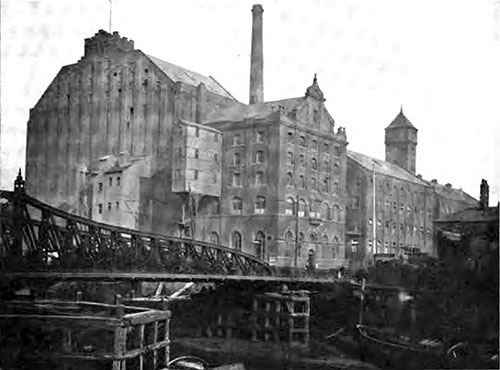
Clarence Flour Mill in Hull, England. GGA Image ID # 146550faf7
Varied Industries in Hull
Hall is one of the three largest milling centers in the United Kingdom, the other two being London and Liverpool. Many thousands of bushels of wheat, grown in the United States, Canada, Argentina, India, and Australia are brought here annually and turned into flour and bran.
The mills are large and fitted with the latest machinery, and, being placed near the River Hull, have every facility for the reception of grain and the shipment of flour.
One of the industries for which Hall has been noted is the manufacture of oils. It ranks as the chief oil compressing city of England, and until recently it was claimed that it was more largely engaged in this business than any city in the world.
The importation of seed for the expression of oil is extensively carried on. Cargoes of linseed, cottonseed and rape seed from India, Egypt and Argentina are constantly arriving to supply the oil mills with the needed raw material. As kindred industries there are large manufactories of paints and colors.
The possibility of making Hull a leading wool market is being discussed, and a beginning has been made by the establishment of a direct steamship service between Hull and Australia.
Transformation of Hull
About eight years ago the long-delayed movement for city improvements began to take shape in Hull. From that time on great changes have occurred in the appearance of the city. Hull has been transformed in appearance from a medieval town to a modern city.
Broad avenues have been cut from the business center of the city to the corporation limits; many new buildings, both public and private, have been erected; the streets have been paved in the best and most enduring manner; the street electric car lines have been acquired, modernized and extended, and the dock system improved and enlarged. The population of the city is estimated at 262,000.
At first the business of the port was carried on at wharves and quays on the Old Harbor; i. a, the mouth of the River Hull. But in the latter part of the eighteenth century these became insufficient for the growing commerce of the town and were supplemented by the first of the series of large artificial basins which now constitute the Hull docks.
The building of these docks was the first step in the modern development of Hull. In the year 1774 the Dock act was passed, followed in 1775 by the laying of the first stone of what is known as the Queen's Dock.
A list of these docks and their dimensions shows that Hull is well supplied with such conveniences of commerce. The Queen's Dock was opened on the 23d of September 1778, and the others followed as below:

Listing of Hull Docks, Year Opened, Cost, and Acres. GGA Image ID # 14665275be
The docks constructed at present cover a total water area of about 193 acres and cost about $19,000,000. All of the above, with the exception of the Alexandra Dock, which is owned by the Hull, Barnsley and West Riding Junction Railway and Dock Company, have become the property of the North Eastern Railway Company.
Hull's Street Pavements
The street pavements are one of the features of Hull. No city in the world is better paved, and cities as well paved can be counted on the fingers of the two hands.
These pavements deserve a description by themselves. Wood is the material used on all the main avenues and streets. It is of the variety known as Jarrah and Kerri wood, grown in Australia.
The success of these pavements is the result not only of the care taken in selecting the material, but also in the manner of laying. A good foundation is put down for the wood to rest upon. This foundation consists first of a layer of chalk ten inches thick.
Over this is placed an eight-inch layer of broken stone and cement, and on this layer of cement are superimposed the blocks of wood which form the pavement.
These blocks, with one side and one edge dipped in a hot mixture of pitch and tar, are placed close together, edge up, and the joints run full of the mixture.
Over this is sprinkled a coarse sea grit, which when ground fine gives a continuous surface almost as smooth as granite, but much more elastic and nearly noiseless. Including the cost of foundation and of laying, these pavements cost when down $2.94 for creosoted deal and $3 42 for Jarrah and Karri per square yard.
The first creosoted deal was put down in 1894. It has never been repaired and is still in very good condition, although under fairly heavy traffic. The Jarrah and Kerri pavements appear as if they would not need repair for a number of years.
While Hull began to improve its streets it acquired its streetcar system. The result has been highly satisfactory, and to-day Hull has one of the best managed and most efficient street electric car systems owned and operated by any city and comparing favorably with the best systems owned and operated by private companies.
One of the chief peculiarities of the Hull system is the double-decked car. In this way the seating capacity of a car is more than doubled, the upper deck accommodating more passengers than the lower deck.
The upper part is generally included, but the windows can be opened, and the cover rolled up like the top of a roll covered desk. This part is devoted largely to smokers. Next to the style of cars, the distinguishing feature of the Hull system is the cheapness of the fare.
The lines average two and a half miles in length, but there are no fare stages or zones. There is a flat fare of 1 penny (2 cents) on all lines and for all distances. The financial result of the low-fare system is equally interesting.
During the last twelve months reported on there were 13.5 miles of double track, or 27 miles of single track, in operation. The gross income was about $560,000, and the cost of operation was about $325,000.
This left a gross profit of $235,000, and, deducting $95,000 for interest and sinking fund, there was left a net profit of $130,000, or an average profit of over $17,000 a mile of double track, which went into the city treasury.
Hull has the advantage of lying midway between two of England's most famous cathedrals—York and Lincoln—while Beverley, the county town of the East Riding of Yorkshire, and which is so near as to be practically a suburb of Hull, has a minster which, in dimension and architecture, can compare favorably with most of the cathedrals of the United Kingdom. The vicinity is also noted for its fine parish churches.
The chief need of Hull today is more direct communication with London. This can only be gained by bridging or tunneling the Humber River. As bridging is probably out of the question on account of the width and shifting channel of the river, a tunnel is the means that will have to be used to bring the city on the Humber into quick and intimate relations with the city on the Thames.
When this is done, Hull will realize its position as the chief commercial city of the east side of England, and it will begin to reap the advantages that belong to that position.
"The Port of Hull," in Dun's Review, International Edition: A Journal for the Promotion of International Trade, Vol. VII, No. 5, July 1906, p. 23-30.

